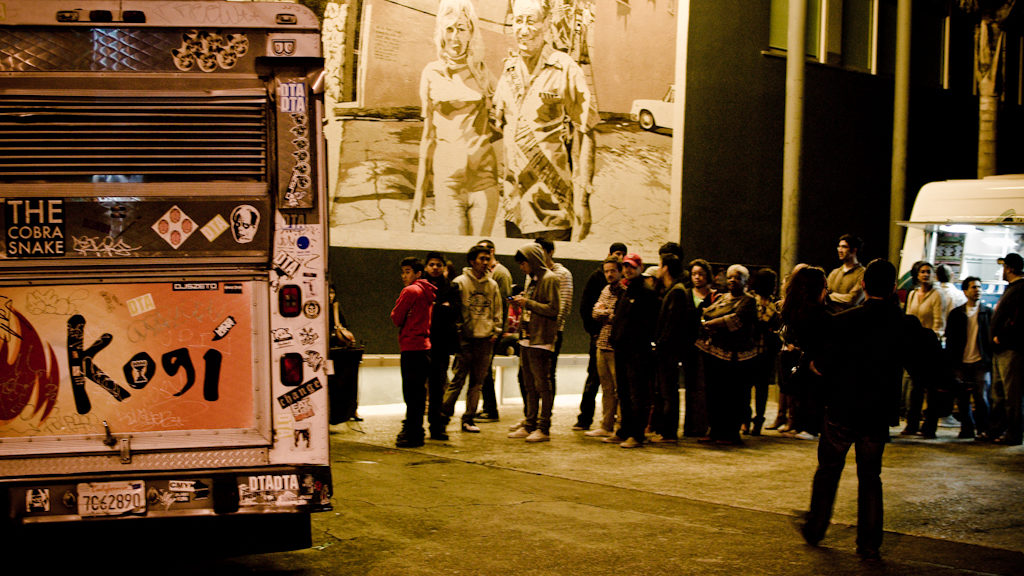By Maggie Deagon
To call one person the face of Los Angeles would be reductive. With its diverse cultural representations and geographic vastness, it seems disingenuous, if not impossible, to represent this city with a single face. But perhaps, I could suggest a single thing—specifically, a food truck. More specifically, the Kogi truck.
You may not have heard of Roy Choi, but certainly you’ve heard of his food. With vehicles catering the entire city, the Kogi truck is perhaps Choi’s most famous creation. Check the Kogi Twitter account (@kogibbq) for live updates on where they’ll be for the day; sometimes they stop at USC for a brief late-night dinner! With all the other food truck options around USC (and in LA for that matter), you may wonder what makes Kogi so special. Well, for starters, the Kogi truck essentially launched the food truck revolution in Los Angeles, so you have them to thank for the gourmet offerings on Jefferson and McClintock. If that’s not enough to impress you, consider this: Roy Choi’s Kogi truck exemplifies the fusion that IS Los Angeles.
Spanish-speaking and Korean-speaking communities make up a significant portion of Los Angeles, particularly in the areas adjacent to USC. Bustling Koreatown is just a few miles away, and authentic tamales and pupusas are available for sale pretty much everywhere—even on our campus each Wednesday at the McCarthy Quad farmers’ market. Roy Choi was born in South Korea but grew up in Los Angeles, specifically South Central. The food he concocts for his Kogi trucks reflects the city in a bite, a effortless combination of two vastly different cultures. Thanks to Roy Choi, kimchi tacos are as popular as french fries. Well, maybe not quite, but more and more people becoming familiar with the combo and favor it as a go-to treat.
Fusion is a sticky subject among food lovers; it tends to stir up issues of authenticity. Roy Choi did grow up in a community where both authentic Korean and Latin flavors ruled, but does he have the right to repurpose the burrito—a staple of a culture not his own—to highlight Korean ingredients? The thing is, Roy Choi has always credited his creations to his community, emphasizing the role the city’s people have played in his flavor combinations. Though the burrito is not his own to repurpose, he sees his fusion as an expression of gratitude.
And it’s more than just talk. He uses his success to take positive action in Los Angeles and change the food landscape as a way to give back to the city that has given him so much. Roy Choi helped open Three Worlds Café, located in the historic core of Central Ave. It’s mission, according to Facebook, is to “celebrate diversity and build community.” He is also in the process of creating a fast food revolution with San Francisco-based chef Daniel Patterson. A location in Watts is currently in the works, demonstrating Choi’s commitment to working in the most underserved areas of Los Angeles. His proposed fast food revolution, called LocoL, is ambitious; he and Patterson aim to completely alter a huge part of the food industry, providing healthy, cheap, and delicious alternatives to longstanding fast food giants. Pursuits like these demonstrate Choi’s sincere commitment to working with the community that raised him and uplifting the neighbors that supported his initial efforts.
Success stories like Roy Choi showcase Los Angeles as a community with a strong sense of connectedness, despite our superficial differences. Ultimately, we seek to empower our neighbors and make positive changes that uplift us all. Thank you Roy Choi for highlighting the uniqueness of our diverse community, harnessing that diversity into strange and wonderful flavors, and, in doing so, empowering others to do the same.
Featured image by Daremoshiranai on Flickr
Maggie is a senior pursuing a double major in Spanish and Social Sciences (with an emphasis in Psychology) and a minor in Korean Studies. Since she was born and raised in Los Angeles, she has been exposed to many cultures, and she developed a strong interest in learning more about the world around her and the people it holds. Last summer, she traveled to Korea with the Global East Asia program and fell in love with the culture (and the food). Her hobbies include running, reading, watching movies, cooking/baking, and writing. She is eager to travel more, learn more languages, and make more friends from around the world.


